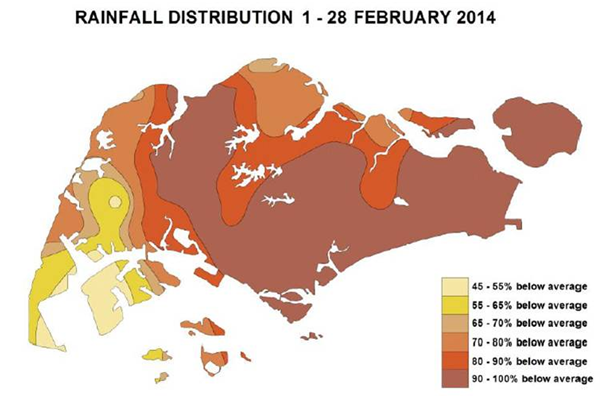JOINT ADVISORY BETWEEN NEA AND PUB
Singapore, 4 March 2014 – The prolonged dry weather affecting Singapore since mid-January 2014 has set a new record for the driest month since 1869. At the Changi climate station, the rainfall total recorded in February 2014 was 0.2mm, breaking the previous record of 6.3 mm in February 2010. During the month, there were only seven days of short duration showers between 7 and 19 February 2014, mainly in the western parts of Singapore. The rainfall totals across 64 rainfall stations range from 45% to 100% below the long-term average of 161.0mm for February. About half the stations, mostly in the southern and eastern areas, recorded monthly rainfall totals below 10.0mm.

2Apart from being the driest month ever, February 2014 is the most windy month in the last 30 years. At the Changi climate station, the average daily wind speed of 13.3 km/hr recorded in February 2014 exceeds the previous high of 12.5 km/hr in January 1985. The prolonged dry conditions have also set a new record for the lowest average daily relative humidity of 74.5%. The previous record low for February and any month of the year was 76.9% (February 1968) and 74.6% (June 2013) respectively. The weather statistics for February 2014 are summarised in Table 1.
|
February 2014 |
Long-term average for February |
| Monthly rainfall total |
0.2 mm |
161.0 mm |
| Average daily maximum temperature |
31.9 deg C |
31.1 deg C |
| Average daily relative humidity |
74.5% |
82.9% |
| Average wind speed |
13.3 km/hr |
8.8 km/hr |
3The last day of significant rainfall was on 16 February 2014, when between 0.2 and 29.0 mm was recorded in various parts of the island. Since then, there has been little or no rainfall, with Singapore entering another period of dry spell on 17 February 2014. This follows the 27-day long dry spell between 13 January and 8 February 2014. The highest recorded rainfall total since 17 February 2014 was 19.2mm at Lim Chu Kang Road. The brief showers yesterday which brought limited rainfall of between 0.2 and 15.2 mm in some parts of western Singapore were not widespread enough to break the current dry spell.
4The dry weather affecting Singapore and the surrounding region is expected to persist in the first half of March 2014. There may be localised showers in the afternoon on a few days, and rainfall is expected to be well below average. Generally fair and warm conditions are forecast for Singapore. The prevailing northeasterly winds are also forecast to remain steady over this period. With the expected onset of the Inter-Monsoon in the second half of March 2014, the winds in the region will turn light and variable in direction. Increased rainfall can be expected in the later part of the month.
5With the dry weather expected to continue, PUB, the national water agency (PUB) has started a public campaign to urge everyone to conserve water. For example PUB has sent circulars to 25,000 non-domestic customers – including the town councils, Management Corporation Strata Title (MCSTs), commercial and industrial buildings, government buildings and schools – to advise them to make adjustments and embark on water-saving measures. Measures like cutting down the washing of cars and irrigation of plants, as well as switching off water features/fountains will help reduce water usage.
6Wafer fabrication plant, Systems on Silicon Manufacturing Company Pte Ltd (SSMC) has cut down on the irrigation of plants and installed all taps in the toilets with water thimbles. “Collectively as a company, I am glad that our Water Efficient Building management has prepared us well to cope with this dry season. In a dry spell situation like now, we are motivated in putting even more efforts to conserve water. At our facility, watering of trees and plants are done in a sparing manner. All our taps in toilet are installed with water thimbles. Individually, on personal level, we also we encourage our staff to do less frequent car wash, use water wisely at home,” said Jagadish CV, CEO of SSMC.
7At home, we can also save water by taking showers under five minutes, washing clothes on a full load and reusing water for non-potable uses. They can also cut down on non-essential water consumption like the washing of cars and irrigation of plants. The amount of water we save will help stretch our limited water resources longer.
8The National Environment Agency (NEA) and PUB will continue to monitor the situation and provide updates as necessary. For updates, visit the NEA website (www.nea.gov.sg) or follow us on NEA Facebook (www.facebook.com/NEASingapore) and NEA Twitter (@NEAsg). For information on water-saving tips, visit http://www.pub.gov.sg/conserve/Pages/default.aspx and www.facebook.com/PUBsg.
– End –
